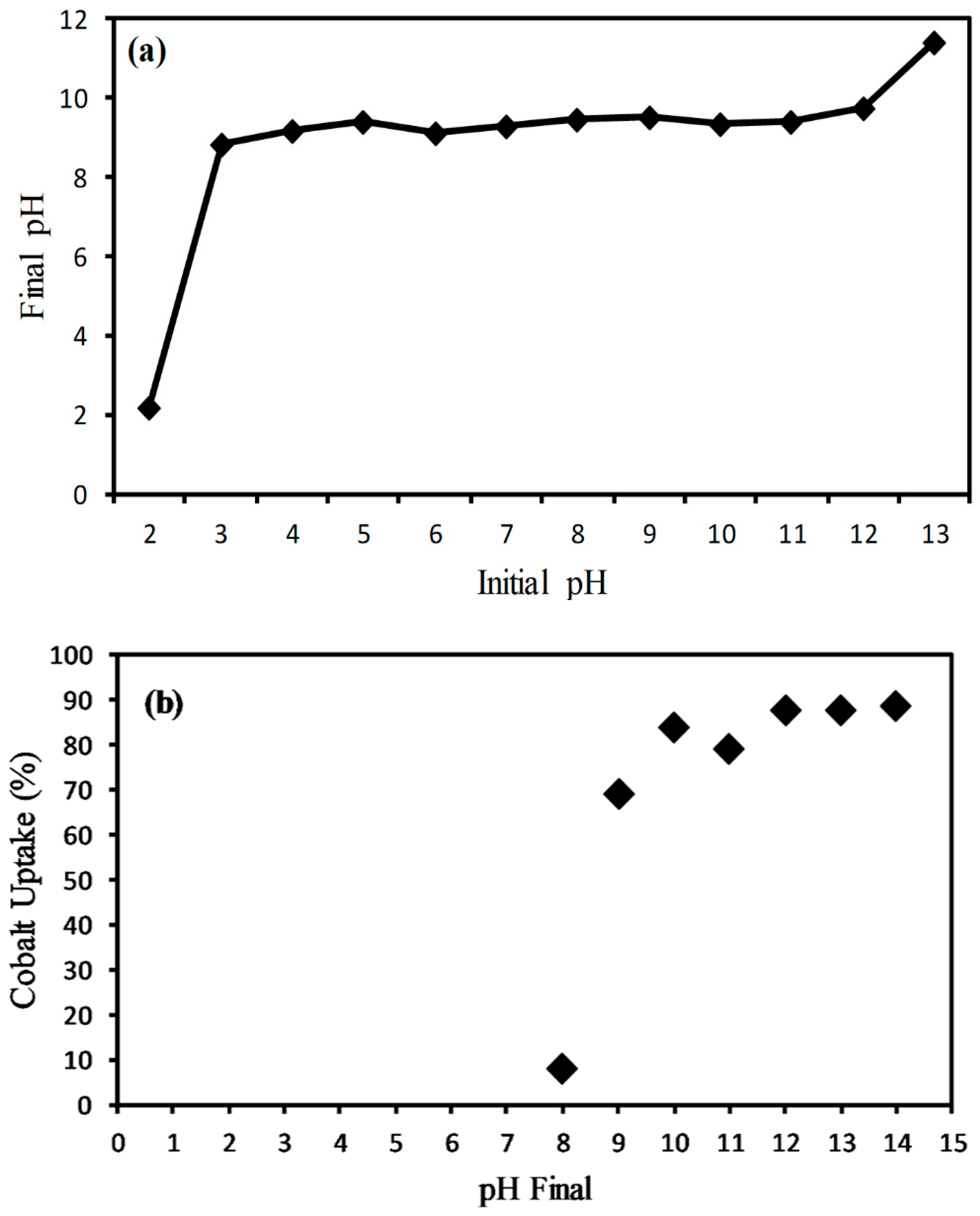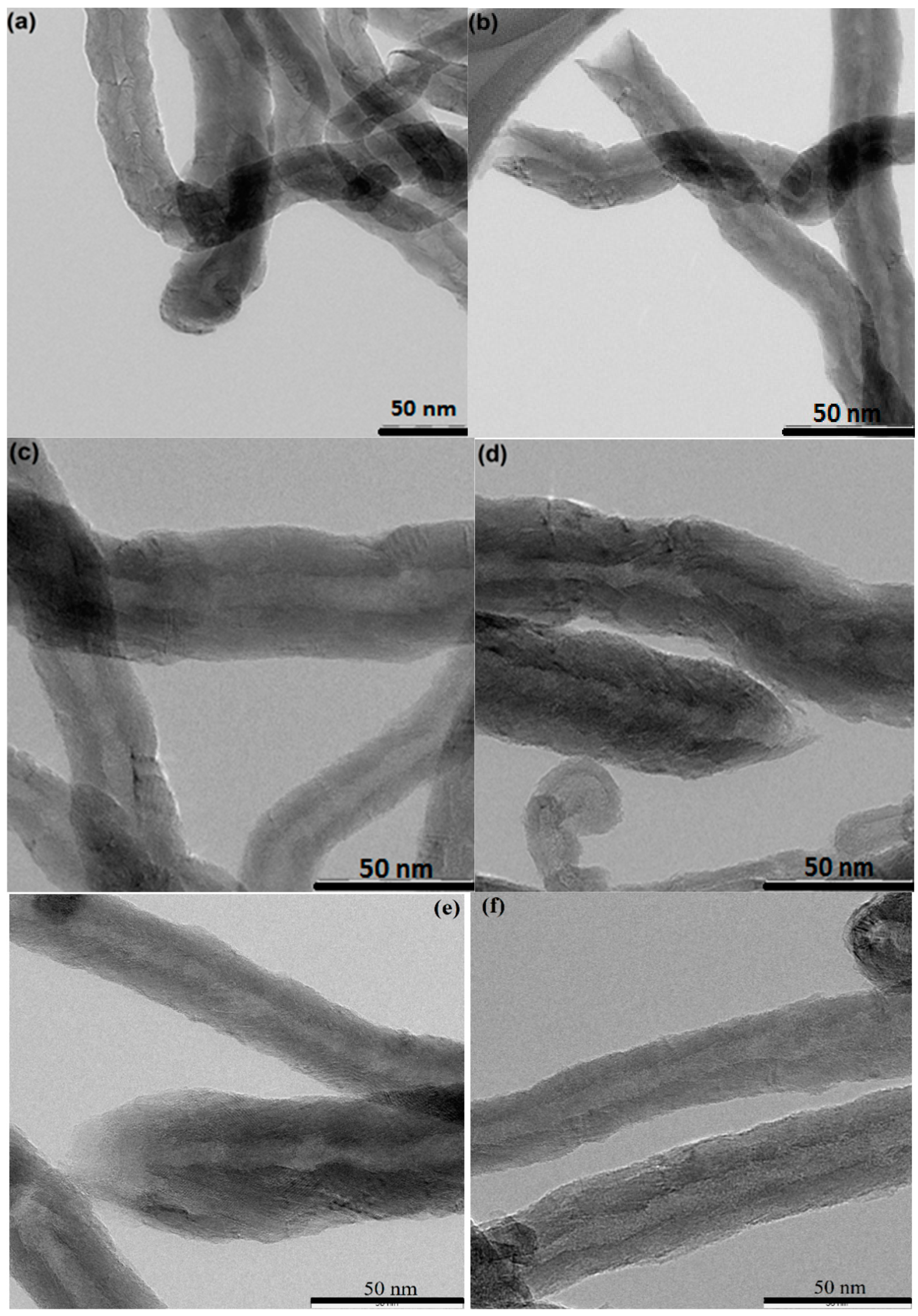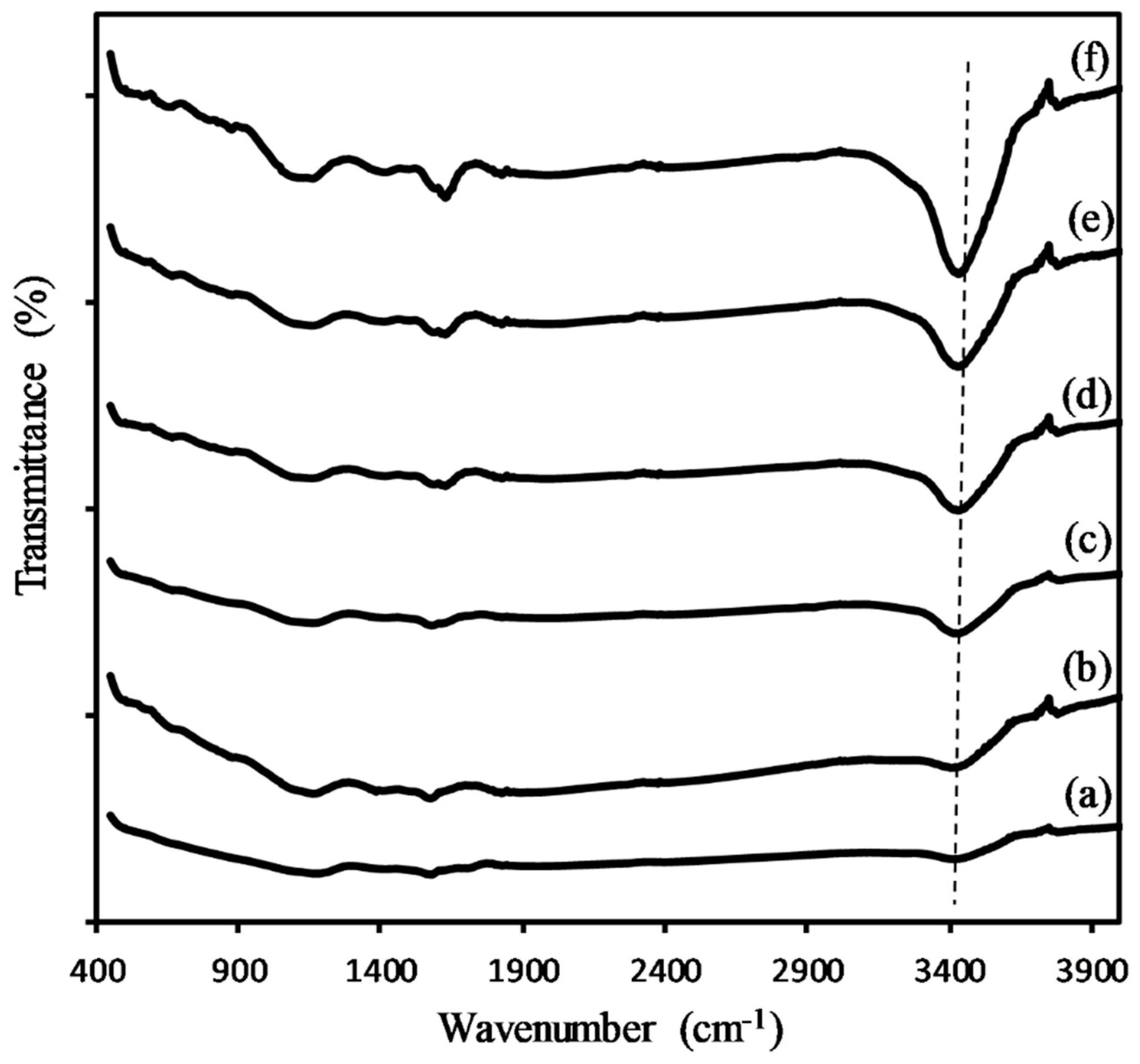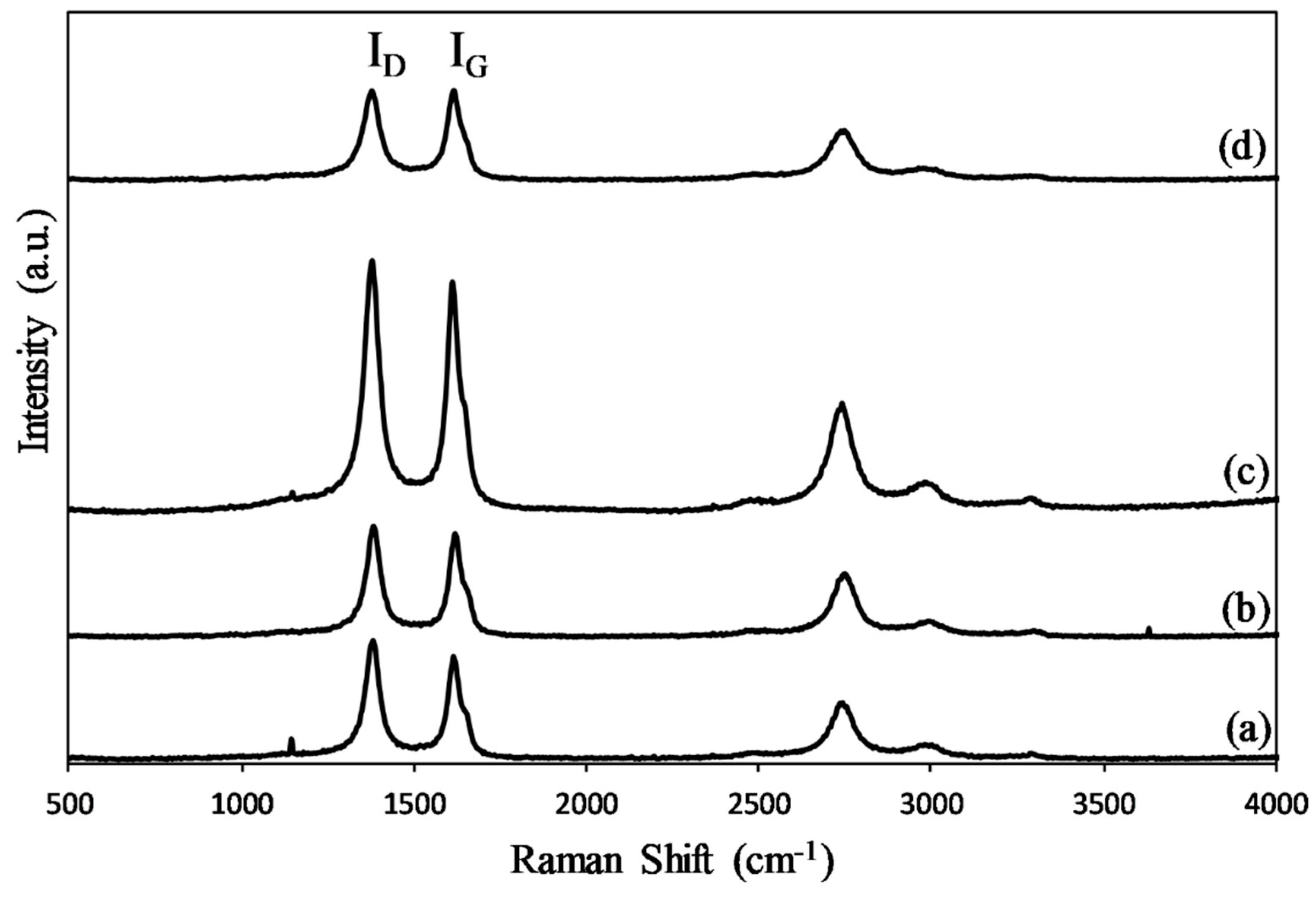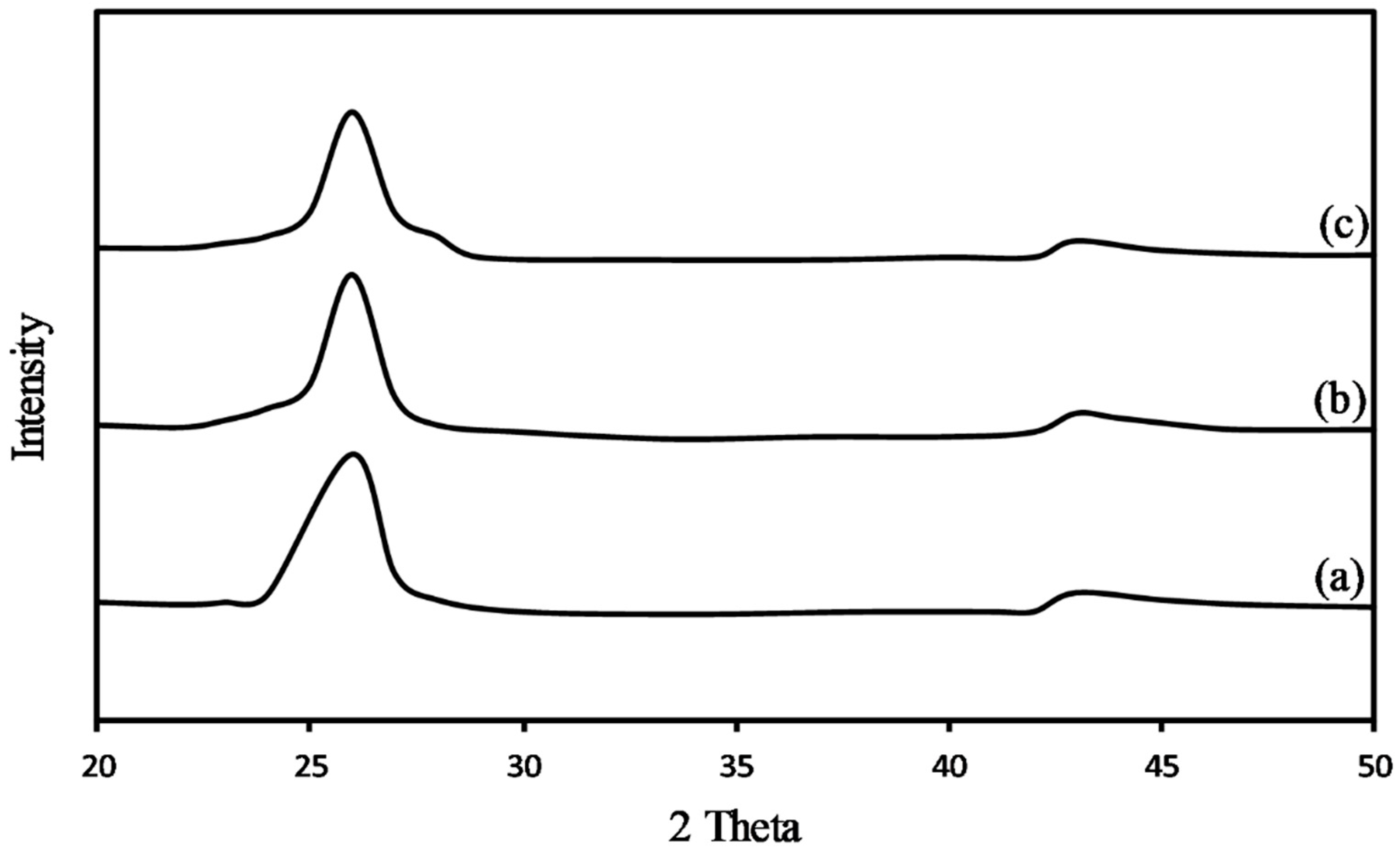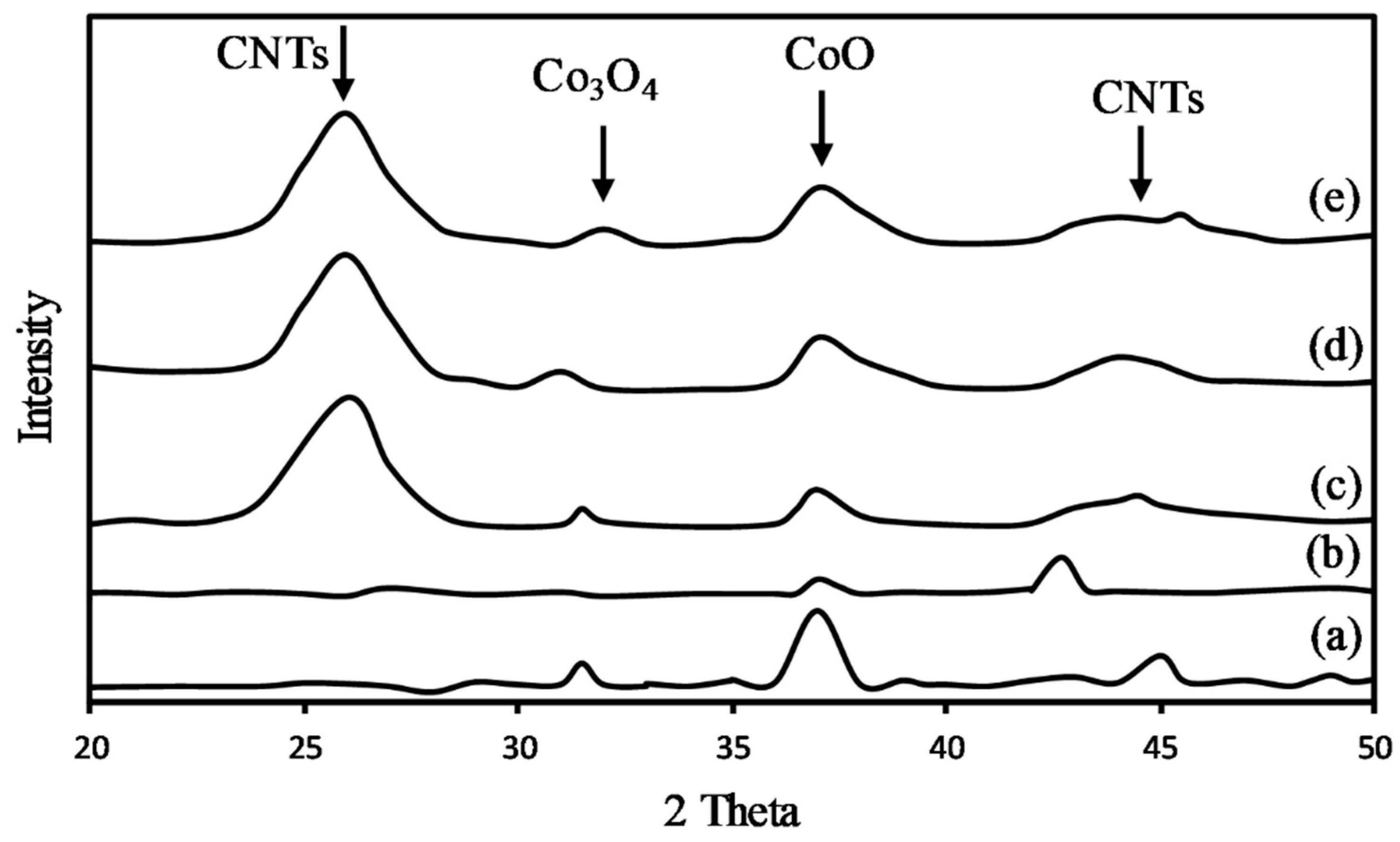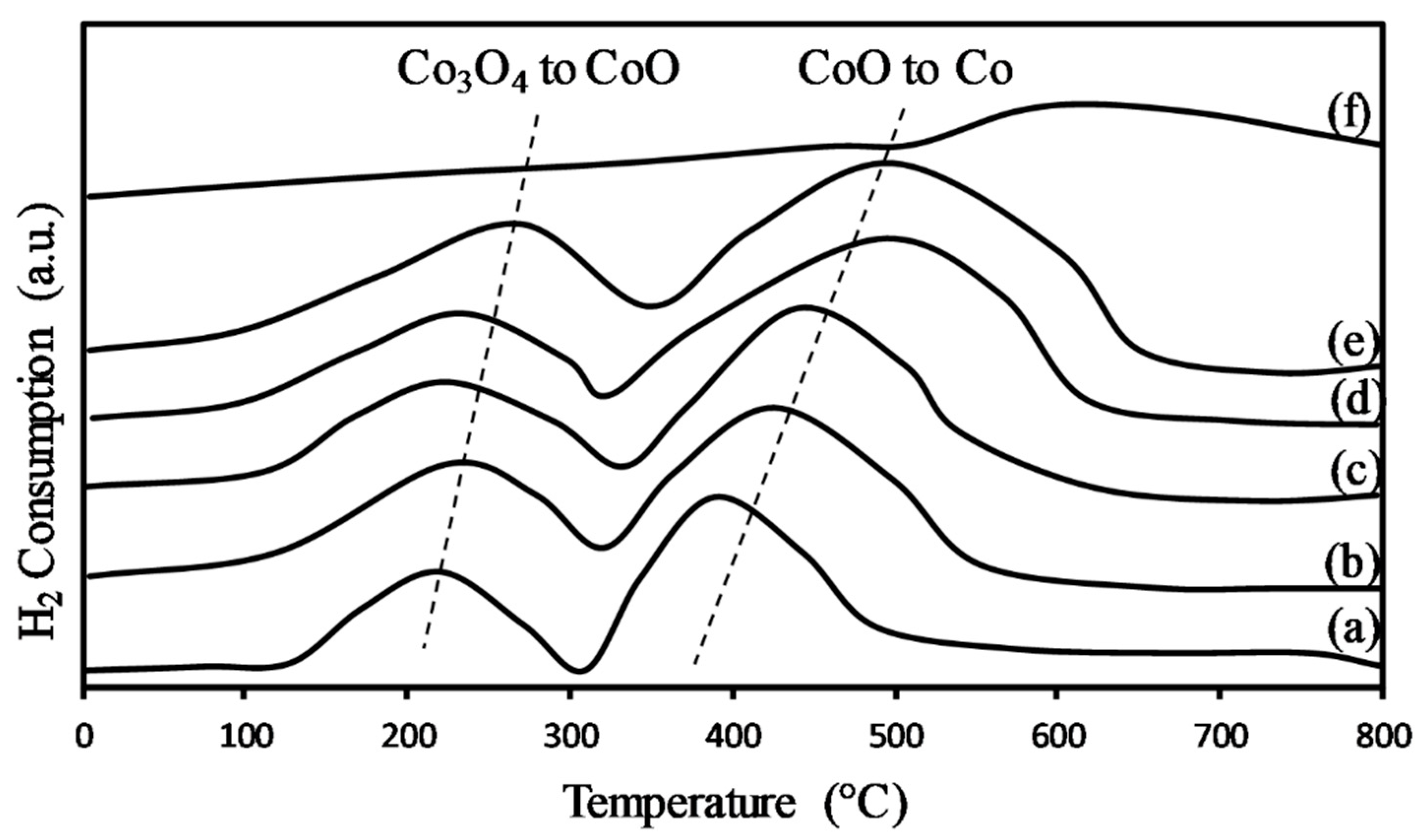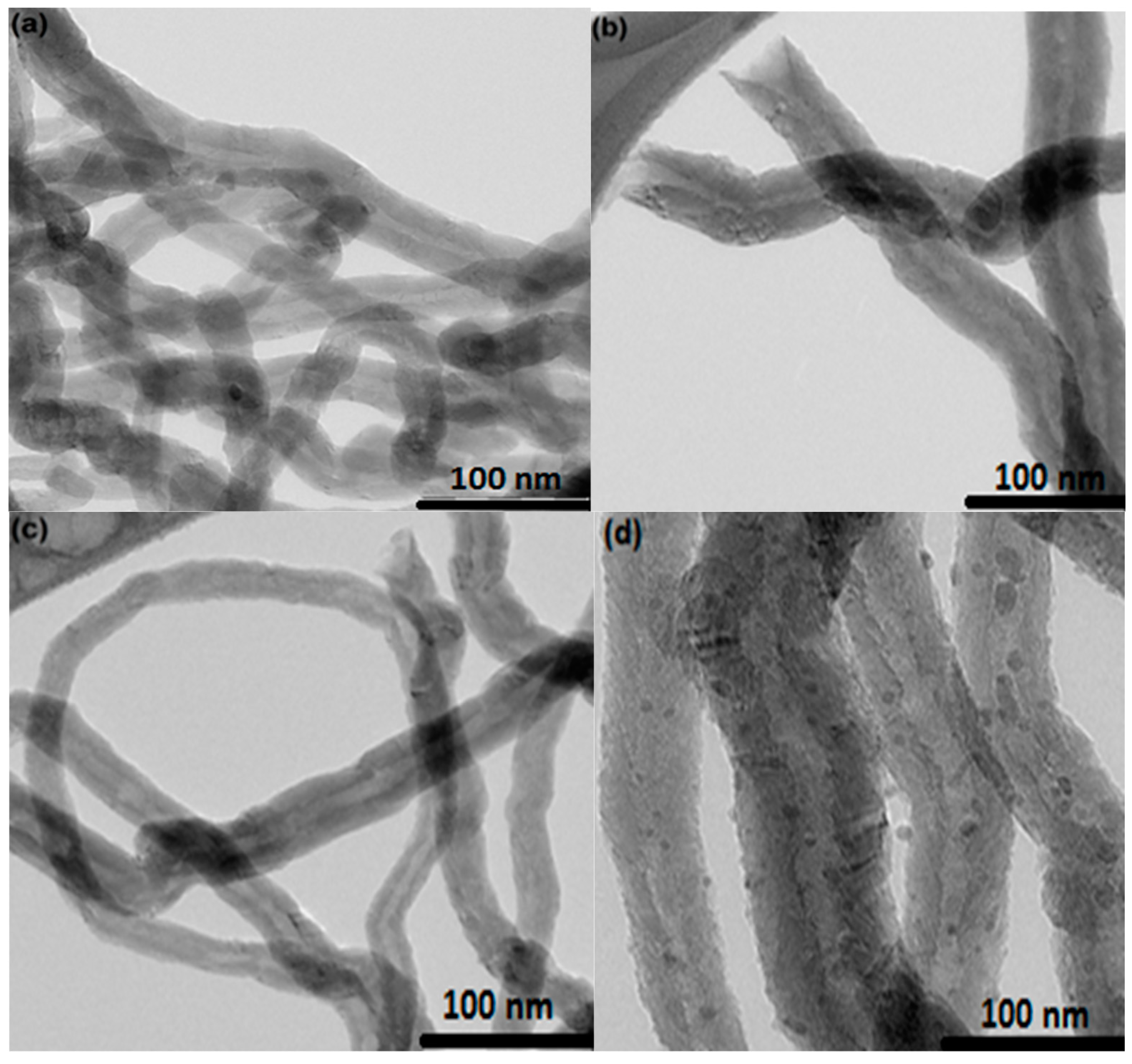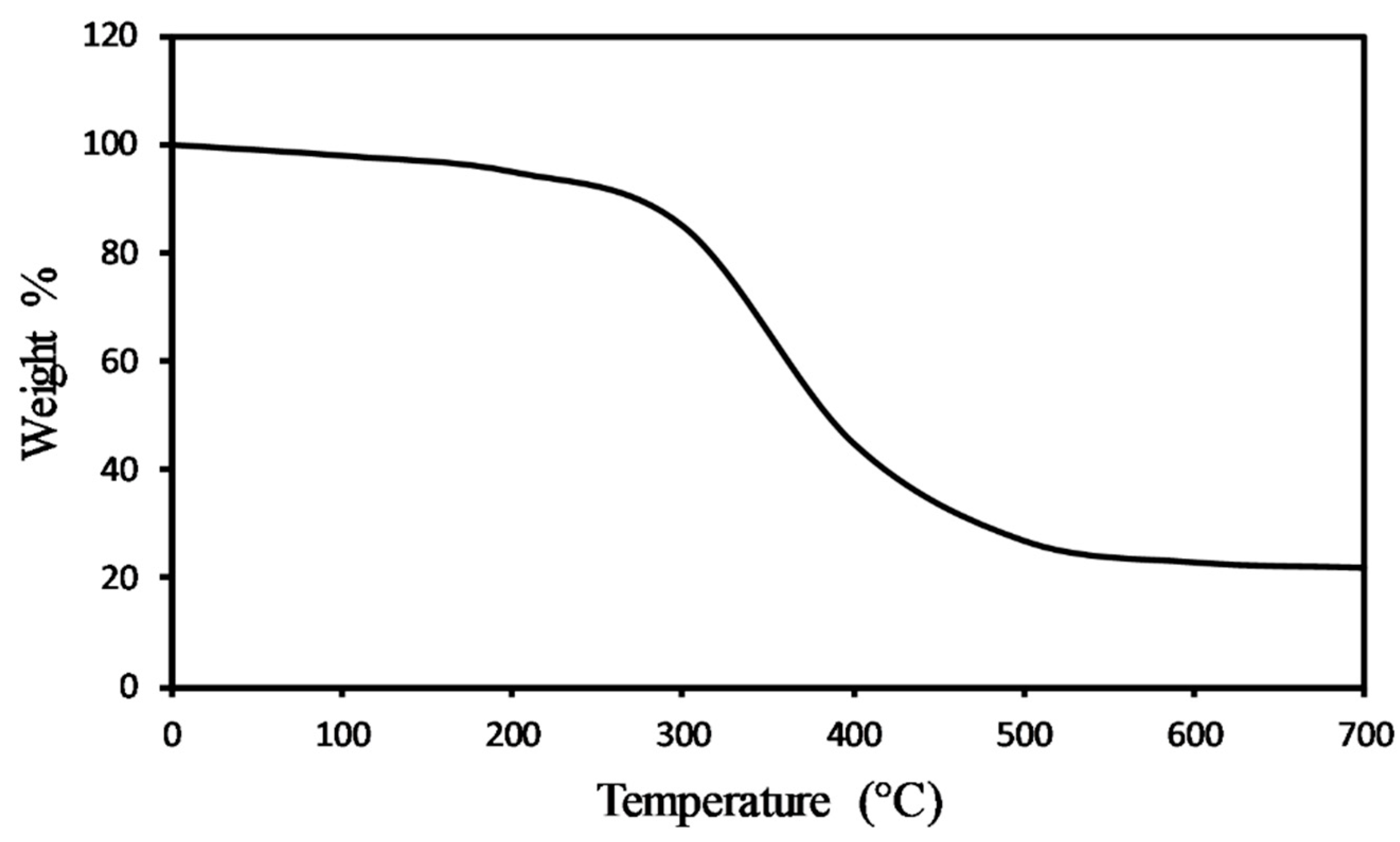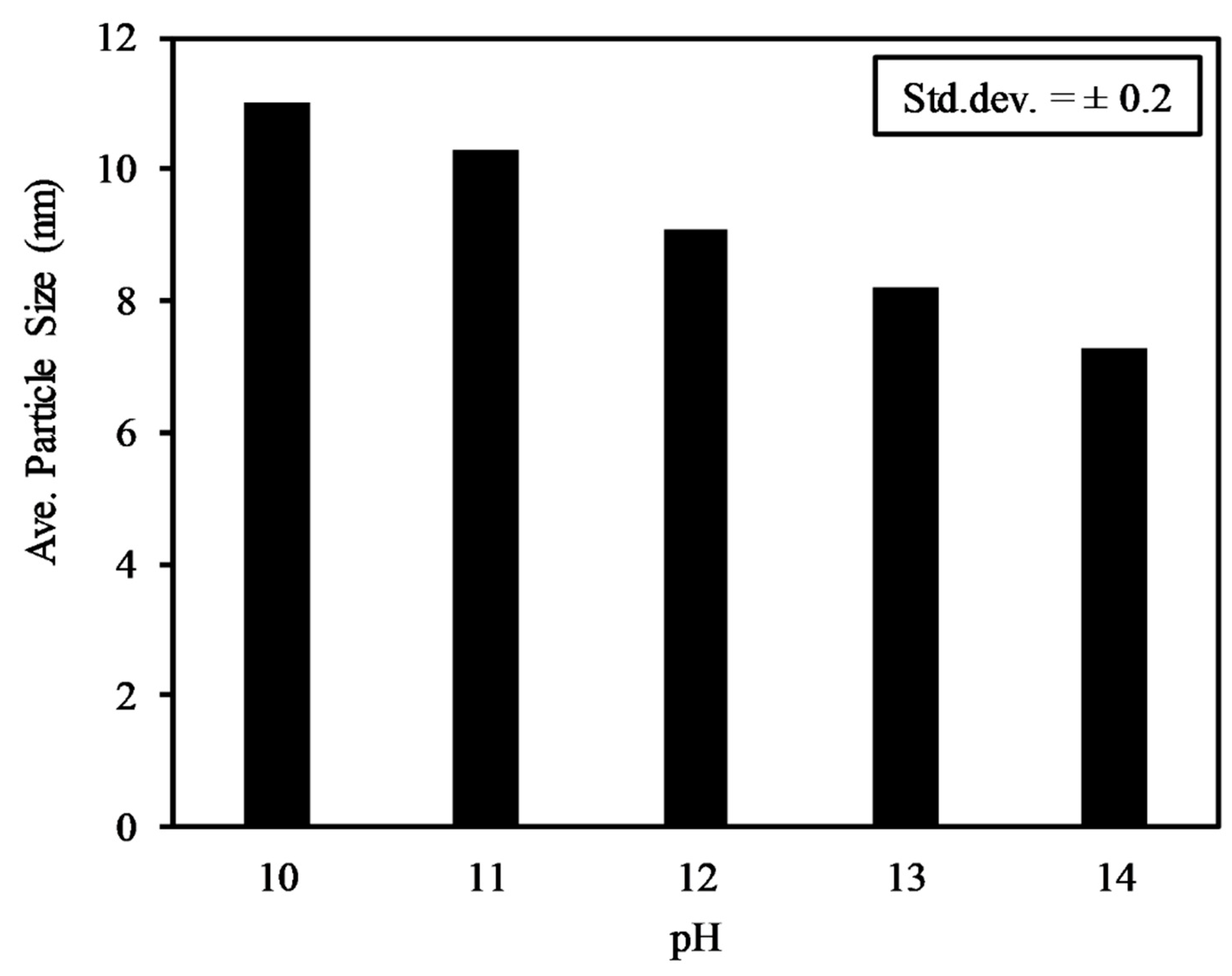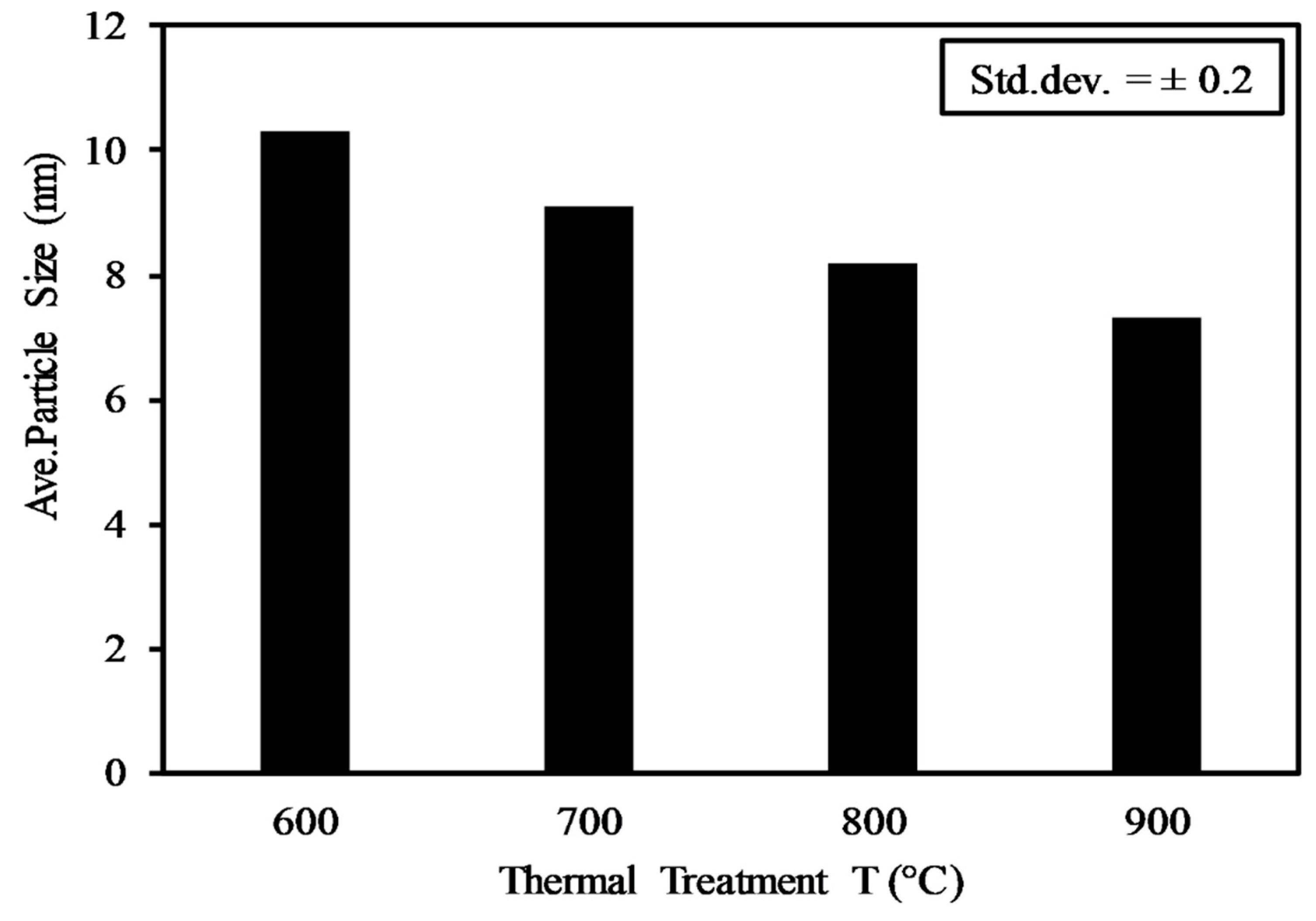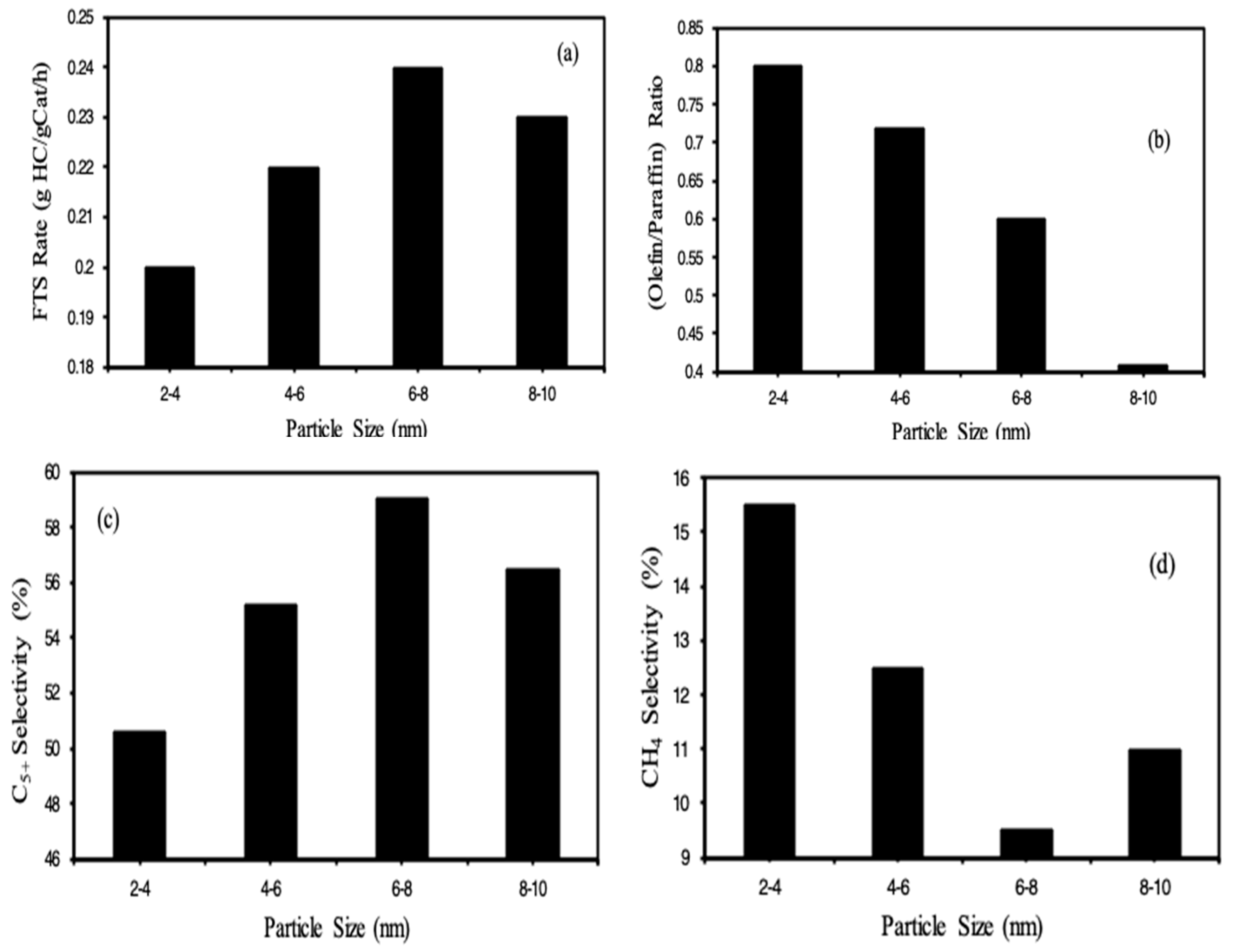From a plateau plotted from the data of the final pH versus initial pH values shown in
Figure 1a, the PZC of the CNT support was found to be 9.5.
Figure 1b shows plot of Co uptake versus pH. From this plot, optimum pH for Co uptake is 14. Prior to the FT reaction, the catalysts were reduction and activated under the flow of H2 at the rate of 1.8 L/h at 220 °C for 2.5 to 10 h. After catalyst activation at the high reduction temperature, the catalysts were cooled down to reaction temperature and flushed with helium gas for 10 min. Fischer–Tropsch reactions were done at 2/1 H
2/CO (v/v) ratio, 40 L/g-cat.h, 240 °C, and at 20 atm pressure.
3.1. Effect of Acid Pre-Treatment Conditions on Co/CNT Properties and Performance
The influence of different conditions of CNT acid treatment on physicochemical properties of the catalysts, FTS activity and selectivity was studied.
Figure 2a–f shows TEM micrographs of as-received CNT, CNT.5A.25, CNT.5A.110, CNT.10A.110, CNT.15A.110, and CNT.20A.110. For the naming of the catalyst samples the numbers before the letter A (which means “acid treated”) represent the duration of acidic treatment (in hours) and last three digits represent temperature used during the acid treatment. From the TEM micrographs they collectively show the acid treatment method was able to uncap the terminal cappings of the CNT and secondly, it introduced defects over the external surface of the CNT. Acid treatment has been shown to be an effective method to uncap CNT and cleave the nanotubes into segments [
29]. Furthermore,
Figure 2 shows the image of as-received CNT and that of the uncapped CNT after refluxing in concentrated nitric acid. As a result of uncapping the CNT it now could allow the cobalt nitrate to enter the various CNT tubular channels with ease during catalyst preparation [
30].
Figure 3 shows FTIR spectra of the as-received CNT where a peak around 1700 cm
−1 can be attributed to the oscillation of carboxylic groups. Upon acid treatments, the peak slightly shifted to a higher wavenumber. The presence of carboxylic groups in the CNT support can be described from possible elimination of the impregnated cobalt nanoparticles from the CNT during the purification process. In addition, a peak at 3430 cm
−1 could possibly be associated with the –OH bending distortion in carboxylic acid groups. Moreover, comparable to that observed by Novoselov et al. [
10]. Finally, it should be noted that the spectra of samples before and after HNO3 treatment, have no significant difference. However, the intensity of OH peak at 3500 cm
−1 was found to escalate with escalation duration of the acid treatment.
Table 1 shows the surface area and pore volume of the as-received CNT and catalyst samples prepared in different experimental conditions. Removal of CNT caps via acid treatment increased the surface area and pore volume. Increasing acid treatment temperature and duration enhanced surface area and pore volume of the catalysts. Cold acid treatment at room temperature leads to an increase of BET surface area from 138.2 to 163.4 m
2/g and for hot acid treatment in 110 °C increased to 270.6 m
2/g.
Simultaneously, for cold treated CNT at 25 °C, pore volume of CNT increased from 0.26 to 0.35 cm3/g and for hot treated CNT increased to 0.56 cm3/g which could be due to presence of defects on CNT as indicated by the TEM results.
Figure 4 shows the Raman spectra of the as-received and acid-treated CNT at various experimental conditions. A peak for a disordered carbon at 1340 cm
−1 attributed to the D-band tangential mode and a peak at 1580 cm
−1 is for G-band peak for an ordered carbon [
31,
32]. Moreover, the second-order 2D feature at about 2700 cm
−1 is observed for the as-received CNT samples and the C–H stretching vibration at 2920 cm
−1 is related to treated samples only.
Table 2 shows the Raman band intensity ratios ID/IG for treated CNT samples. Ratios of ID/IG represent the quality of carbon nanotubes of the catalyst supports. Ratios of ID/IG increased slightly with increasing duration of acid treatments. The results revealed the number of defects on the outer surface of CNT which increased with prolonged acid treatments. Therefore, the treated CNT as catalyst support could lead to enhanced dispersion, reduction in sintering and deactivation of metal catalytic particles during a Fischer–Tropsch reaction.
XRD patterns of CNT which were pre-treated under different experimental conditions are shown in
Figure 5. Peaks at 2θ of 25° and 43° on
Figure 5 correspond to those of carbon nanotubes and increasing acid treatment temperature has no influence on the intensity of the peaks.
Figure 6 shows the XRD patterns of Co supported CNT that have undergone various acid treatments. While the 2θ peaks at 25° and 43° in
Figure 6 correspond to those of carbon nanotubes, other 2θ peaks at 32°, 36.8°, and 45° can be attributed to different crystal structures of Co
3O
4 and CoO [
33]. The most intense peak at 36.8° in the XRD patterns was attributed to CoO and no peak for the CNT support was observed.
Table 3 shows further data for the average particle size of the Co3O4 catalyst calculated from the XRD patterns and the Scherrer equation using peak at 36.8° and TEM images [
34].
Increasing BET surface area and uncapping of the CNT tubular ends helped to increase catalyst active site distribution and lower the overall particle size. From
Figure 2, by increasing acid treatment temperature from 25 to 100 °C, it led to an increase in the number of defects on CNT and provided an anchoring site for metal particles. On the other hand, acid treatments cleaved CNT and as a result, introduced functional groups on the surface of nanotubes [
35]. Acidic functional groups on the surface of the CNT support have provided active sites during the preparation of the catalyst. Incipient wetness impregnation is the most common method of heterogeneous catalyst preparation and is carried out with a solution of the catalyst precursor, then dried and further captivated by either calcination and/or reduction. CNT are naturally hydrophobic and have low solubility in water-based solvents. Acidic functional groups decrease CNT hydrophobicity and introduce further surface modifications making them more susceptible to the aqueous solution of a catalyst precursor [
35]. In addition, acid treatments could lead to more homogeneously dispersed impregnation of metal particles and a reduction in metal particle size as observed by the data from the TEM images and XRD patterns (
Table 3).
Figure 7 displays the TPR spectra of the catalyst samples. The first peak in the TPR profile was in the range of 177 °C to 220 °C which was contributed to a reduction of Co
3O
4 to CoO. Furthermore, the second peak was attributed to the decline of the second step, CoO species to Co which was in a range of 377 to 477 °C. Gasification of the CNT support was represented by peak (f) at 600 °C. Acid treatments of the CNT support led to a decrease reduction temperature (from 294 to 200 °C) for the first TPR peak and for the second peak, the reduction temperature declined from 481 to 456 °C. In addition, for the acid treatment temperature at 100 °C, the first peak in the TPR profile decreased from 384 °C to 363 °C and the second TPR peak decreased from 481 to 448 °C. Acid treatments could result in uncapping of the CNT terminal end caps and cleaving the tubes at defects and imperfections caused by the acid treatment. This led to a lower temperature needed for cobalt particles reduction. While the reduction percentage from the H
2-TPR profile can be calculated from Equation (4).
Table 4 shows a catalyst reduction percentage during the H2-TPR analysis and
Table 4 also shows that by increasing acid treatment duration up to 15 h it leads to an increase in reduction percentage up to 18.5%. Acid treatment applied in other to introduce OH functional groups to CNT surface and opening of CNT caps for catalyst encapsulation purpose. Tube shape CNT structure with open caps resulted confinement of particles in CNT channels and prevent metal active sites from agglomeration, sintering and deactivation. Increasing the acid treatment duration more than 15 h makes CNT to break down to the shorter segments and change the tube-shape CNT unique structure and properties and consequently lower reduction rate.
Table 5 shows the effect of different condition of acid treatments on the CNT thermal treated support against catalyst performance. With increasing acid treatment temperature and duration from 25 °C and 5 h to 110 °C and 15 h, FTS rate and % CO conversion, increased from 0.17 to 0.24 and 41% to 58.7% respectively.
Table 5 also shows the WGS reaction rate decreased from 0.45 to 0.35 for higher temperature and longer duration of acid-treated CNT supports. By applying acid treatments on a CNT support it could increase the BET surface area, catalyst reducibility, number of surface active sites, FTS reaction rate and on the other hand, decrease catalyst particle size [
36]. After the CNT acid treatments and an opening of the CNT terminal caps, the exterior surface of the CNT becomes more electron-rich relative to their electron-deficient interior surface [
37]. The effect of surface electron distribution could influence the catalyst’s active sites.
Table 5 shows CO conversion increased by up to 58.7%.
Figure 8d shows confinement of catalyst active sites inside the CNT channels could lead to an interaction formed between the CNT internal surface Co particles and hence, causing more CO conversion.
In addition to the removal of the CNT end-caps, acid treatments could present a large number of functional groups on carbon nanotubes [
38]. Acidic functional groups enhance hydrogen adsorption on the catalyst surface and increase the FTS rate. On the one hand, confinement of catalyst particles localized in certain areas across the CNT channels could lead to the increased density of reactants, higher local pressure and a suitable condition for syngas conversion to hydrocarbons [
37].
Table 5 indicates a drop-in selectivity of methane from 44.3% to 9.5% and an increase from 35.1% to 83.2% for C
5+ selectivity for the acid treated Co/CNT catalysts at various experimental conditions. The rate of olefin to paraffin ratio increased from 0.42 to 0.60 for the acid-treated CNT support and such an increase is due to a lower termination rate for the paraffin reaction.
3.2. Effects of Thermal Pre-Treatment Conditions on Co/CNT Properties and Performance
Thermal treatments were applied to induce structural changes in acid treated CNT. Thermal treatments can be exploited to introduce certain defects on nanotubes and also change their electrical properties. The application temperature for thermal treatment ranges from 600 °C to 900 °C [
39,
40]. In this study, the effects of acid and thermal treatments on the properties of CNT is introduced. The TEM micrographs of the CNT support and Co/CNT samples are shown in
Figure 8. In this study also, thermal treatments were carried out after the acid treatments. TEM analysis shows that thermal treatments on CNT changed their morphology and introduced defects on the outer surface of CNT. After the thermal treatments, metal Co particles were presented on the CNT by a strong electrostatic adsorption method.
Following the acid pre-treatment step, functional groups containing oxygen such as –OH introduced on the surface of CNT could adsorb Co ions during impregnation method through the SEA process [
41]. The –OH groups needs to be removed from the external surface of CNT due to a subsequent thermal treatment on nitric acid-treated CNT. But the –OH group was maintained in the interior surface of the CNT channels. By increasing temperature of the thermal pre-treatment, this feature resulted in increased encapsulation of cobalt oxide nanoparticles in CNT channels.
Table 6 shows the elemental composition of the calcined 10% total metal loading of Co/CNT catalysts after the acid and thermal treatment studied using energy-dispersive X-ray spectrometry. After the acid and thermal treatment, the purity of carbon nanotubes did not change (purity > 95%). The O content indicates functionalization has taken place and Co content was comparable to that observed from the AAS result.
Reducibility of a catalyst is one of the key factors affecting catalyst performance. The TPR profiles of pristine and acid-treated CNT are shown in
Figure 7. Two reduction peaks were detected for the Co/CNT samples. The first peak was recorded around 300 °C which was associated with the reduction of Co
3O
4 to CoO [
42] and the second peak was recorded at around 550 °C which was related to the reduction of CoO to Co [
42].
The amount of the chemisorbed hydrogen calculated from the H
2-TPR profiles and other associated parameters are tabulated in
Table 7. Hydrogen consumption by the Co/CNT samples increased with increasing temperature of the thermal pre-treatment of the CNT support which could be due confinement of Co particles inside the CNT channels, a bigger particle size, and a lower metal-support interaction. Equations (1) and (2) were used to calculate reduction and dispersion percentage, respectively [
43].
Reduction % and the number of Co active sites [
44] on the catalysts can be obtained from H
2-TPD profiles [
45] and the results are presented in
Table 7. Increasing temperature of the thermal pre-treatment from 600 °C to 900 °C resulted in a significant improvement of the catalyst reducibility and dispersion of Co nanoparticles. Increasing Co/CNT reducibility could be related to unique textural properties of CNT and low interaction of Co nanoparticles with the thermal pre-treated CNT support at high temperature (900 °C). CNT-supported catalysts contained a high number of active sites inside the CNT channels which increased with increasing temperature of thermal pre-treatment. The observed trend could be because of narrow particle size distribution, improvement in reducibility, and high dispersion of Co oxide nanoparticles inside the CNT support channels [
46,
47].
Thermogravimetric analysis results are shown in
Figure 9 for the CNT acid and thermally treated sample at a high temperature of 900 °C (CNT.A.900). A sharp weight loss for the catalyst was observed to start around 300 °C and continued up to 500 °C. After 500 °C the weight loss became negligible. Calcination of the catalyst at 300 °C for 3 h removed moisture and counter ions present in the catalyst.
3.3. Effect of pH and Thermal Pre-Treatment on Catalyst Properties and Performance
In an aqueous medium like water, when particles were dispersed in a polar medium, surface charges on particles could determine the state of aggregation or dispersion. With a change in pH, the state of particles like aggregation or dispersion is influenced by polarity and extent of surface charges developed by particles [
48].
Figure 10 shows a plot of pH values versus particle size in a 10 wt% metal particle suspension. With increasing pH to 14, the particle size increased and reached its optimum largest size (6–8 nm) when pH increased to 14. In order to measure the average particle size of the catalyst particles, 150 cobalt particles were analyzed by micrographs obtained from TEM analysis.
Figure 11 shows the influence of thermal treatment temperature on cobalt particle size for the prepared samples at pH 14. With increasing thermal treatment temperature from 600 to 900 °C, the cobalt particle size decreased from 10.2 to 7.3 nm accordingly. A decrease in cobalt particle size was due to thermal treatments which removed more OH functional groups from the external surface of the CNT support channels and therefore, led to a higher uptake of particles inside the CNT channels.
The following describes the Fischer–Tropsch synthesis (FTS) reaction that was carried out for the Co catalyst samples prepared on the CNT support that have undergone thermal pre-treatment at various temperatures.
Table 8 shows at same thermal treatment temperature (900 °C), increasing pH during the FTS reaction from 12 to 14, led to an increase in CO conversion from 40.4% to 58.7% respectively.
During the preparation of the studied catalysts via the strong electrostatic adsorption (SEA) method, increasing the pH led to a higher uptake of metal Co nanoparticles on the CNT surface and thus resulted in a higher CO conversion. Increasing the pH during the Co uptake step via adding concentrated nitric acid led to introduce higher rate of OH functional group and consequently led to uptake more catalytic active sites on the CNT support and led to an increase in C5+ from 69.7% to 83.2%. The highest C5+ selectivity (83.2%) for the 10% Co/CNT catalyst belongs to the sample prepared at 900 °C thermal treatment and pH 14. Decreasing the pH and thermal treatment temperature led to a decrease in C5+ selectivity as low as 69.7%. In addition, the olefin to paraffin ratio also followed the same trends with those observed for the C5+ selectivity. The highest olefin to paraffin ratio (0.60) belongs to the 10% Co/CNT catalyst sample which was prepared at 900 °C thermal treatment and pH 14. On the other hand, decreasing the thermal treatment temperature and pH led to a decrease in olefin to paraffin ratio as low as 0.50. In order to confirm results reproducibility, all catalysts were reproduced twice.
Figure 12 indicated the effects of cobalt particle size on C
5+ and CH
4 selectivity, olefin/paraffin mass ratio and FTS rate. The results show increasing metal particles beyond 8 nm in particle size led to a decline in the FTS activity. Bezemer et al. reported a higher FTS activity and a higher cobalt active sites on the CNT surface having less than 10 nm particle size distribution on carbon nano-fiber supports [
49,
50]. Chen et al. reported that particle size is not the only role player in an FTS activity but also confinement of catalytic active sites inside CNT support channels has a significant effect (
Figure 8d) [
51].
Figure 12 shows a decline in selectivity of CH
4 and an increase in C
5+ in the range of 6–8 nm catalyst particle size.
